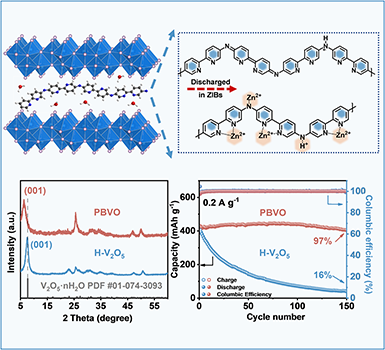Recently, the research team of Yang Weishen and Zhu Kaiyue in our group has made new progress in the research of aqueous zinc-ion battery cathode, which has brought a major breakthrough to the development of aqueous zinc-ion batteries.
Driven by the global energy transformation and carbon neutrality goals, the development of safe and low-cost new energy storage technologies has become an urgent need. Aqueous zinc-ion batteries (ZIBs) have attracted much attention due to their unique advantages: the zinc metal anode has a high theoretical capacity (820 mAh g-1) and a low redox potential (-0.762 V vs. SHE), and the water-based electrolyte completely solves the flammability risk of the organic system, greatly improving safety and reducing production costs. However, the development of cathode materials has seriously restricted its commercialization process. Although vanadium-based oxides have achieved high capacity (>400 mAh g-1) by virtue of multivalent states (V3+-V5+) and layered structures (such as V2O5·nH2O), the side reactions caused by vanadium dissolution during the cycle will cause irreversible capacity decay.
The team successfully designed a new conductive polymer poly-[2,2'-bipyridine]-5-amine (PBpyA), and composited it with vanadium pentoxide hydrogel (V2O5·nH2O) through in-situ intercalation technology to prepare PBVO cathode material with ultra-large interlayer spacing (14.1 Å). This innovative design enables the battery to achieve a high specific capacity of 454.6 mAh g-1 at a current density of 0.1 A g-1, and maintain 84% of the capacity after 2000 cycles at a high rate of 5 A g-1.
The above work was recently published in Chemical Science under the title "A multinitrogen π-conjugated conductive polymer stabilizing ultra-large interlayer spacing in vanadium oxides for high-performance aqueous zinc-ion batteries". The first author of this work is Li Weijian, a doctoral student in the 504 group of our institute. This work was funded by the National Natural Science Foundation of China, the Innovation Fund of our institute and other projects.
The article links: https://pubs.rsc.org/en/content/articlelanding/2025/sc/d5sc01545f#fn1

